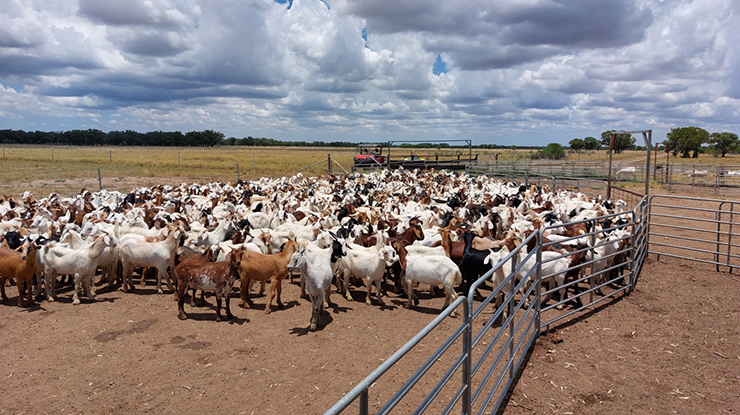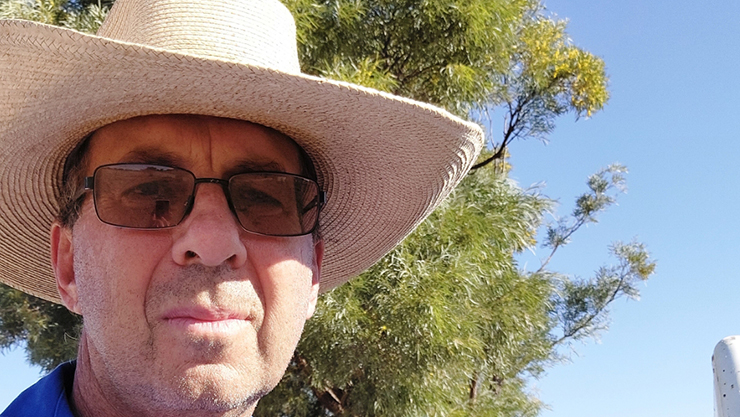 Goats at Angus MacDonald’s property at Blackall, Western Australia. Image: Angus MacDonald.
Goats at Angus MacDonald’s property at Blackall, Western Australia. Image: Angus MacDonald.
Breeding management key to productivity gains
Key points
- Western Queensland grazier, Angus MacDonald, made the decision seven years ago to diversify his operation from a primary Dorper sheep operation to include goats.
- Breeding management decisions over time have driven improved growth rates and body condition score.
- Results are achieving a marketable weight range in a shorter timeframe, driving profit growth for the business.
In the seven years since Angus MacDonald diversified his sheep operation to include goats, strategic breeding management decisions have been key to driving productivity gains.
Angus runs an even split mixed Dorper sheep and goat operation on gidgee and downs country at Blackall in western Queensland. He currently runs around 1,800 ewes and 1,800 does.
Angus made the decision to diversify his operation from a primary Dorper sheep operation to include goats in order to create another revenue stream.
Since then, Angus has focused on implementing effective breeding management decisions over the years to achieve a more productive, profitable goat herd.
Making the change
For Angus, strategic breeding management decisions have been key to driving productivity gains across his operation.
“For the most part, I treat the goats the same as my sheep. I control mate for five weeks, pregnancy scan, and supplement lactating females,” Angus said.
“We started running goats in 2016 and have used electronic identification devices (eIDs) from day one to help with herd management.
“But a big part of it has been our work on getting better genetics in the herd to ensure good structure and body condition.
“For us, that means culling out structural faults from feet to teats and type, and trying to increase the condition score.”
Angus focuses on rearing higher content Boer and Boer-cross goats to ensure that the quality is maintained and performance continues to improve.
“The goal is to achieve higher mature weaning and growth rates, and by continually improving our herd we’ve found that our weaning rates are better and growth rates are streaks in front,” Angus said.
“A focus for us is to improve the mature body rates of females, so each year we look to raise the level of joining weight of females with goats being ideally in the 50–60 kilogram weight range, and I cull out the bottom end of my mature animals.
“Female body score is important. We found a significant differential between rangeland and Boer goats, with about 50% differential in weight gain at 10 months of age, which is significant.
“When females get pregnant at such a young age, it restricts their growth to an achievable outcome, so we don’t join maidens until nine to 10 months of age,” Angus said.
Angus aims to turn off goats at a target weight range of 40–45 kilograms at 10–11 months of age.
Finding value in quality bucks
Utilising quality bucks has also been a core part of improving herd productivity for Angus.
“When selecting bucks, critical factors we look at are weight for age, structure, type and confirmation, attitude, and scrotal circumference,” Angus said.
“I have a pretty good feel for what we’re looking for, but to help us out, most of the genetic information we use to identify quality bucks for breeding is morphology.
“We undergo morphology testing on our males, so we can keep a number of bucks from my own program.
“I learnt through morphology testing that quality and quantity of semen is different, with some not being sexually mature.
“I know there are many who don’t do this testing, largely because goats have a reputation for being fertile, but I learn a lot through it and it’s worth it in my opinion. Then if they don’t perform, they’re culled.
“Say I keep 100 bucks, after 90 days, I’ll go through and cull. Out of that you might only end up with 15–20 that are worthy.
“Along the way, I’ve noticed that goats can have structural issues up to 15–16 months of age such as developing bad feet as they grow, so we reassess at this stage, and cull if we spot any issues.
“This is one of the main reasons that I don’t really go with stock sales, because there isn’t that clarity over genetics.
“That being said, there are some bucks we do buy at studs, but until recently, I struggled with what was on offer.
“I am particular about feeding, not wanting them to be supplementary fed, I prefer to use quality bucks from our own operation that have been paddock born and raised, so that we’re breeding and retaining our own quality genetics.”
This increased focus on herd development has reaped benefits on-farm for Angus.
“We’re getting a fleshier animal, a more consistent article, and are achieving a marketable weight range in a shorter time frame, which as we know, is critical to driving profit.”

Western Queensland grazier, Angus MacDonald. Image: Angus MacDonald.
Lessons along the way
When first diversifying into goats, Angus engaged a consultant to learn about best practice.
“We used consultants for the first three years of running goats, but really it was just a fair bit of trial and error. We implemented changes, evaluated outcomes, and did a lot of online research,” Angus said.
“And where we could, we implemented a similar regime to what we do with the sheep operation – joining for five weeks and then weaning at 14 weeks of age.
“There have been a lot of lessons along the way. A few years ago, we tried running sheep and goats together and I joined them as one, but my conception rate in the Dorpers was way down, and goat conception was basically 0–10% so I realised I had to split to join.”
Angus said those looking to get into the goat industry or boost the performance of their herd, should get along to information days and ask producers who have been in the industry for a while for advice.
“Compared to other livestock groups, there isn’t a lot of information out there about goats. So go along to field days, goat days, information sessions, and BredWell FedWell sessions where you can. I’m a big believer and pursuer of those type of events,” Angus said.
“And understand your selection criteria to get the most of out of your herd.
“There’s so little data out there about goats compared to sheep, and a dire need for more information to be available for the stability of the goat industry, so people can invest with security. So, chat to your neighbour, head to information sessions, and seek as much information as you can.”



